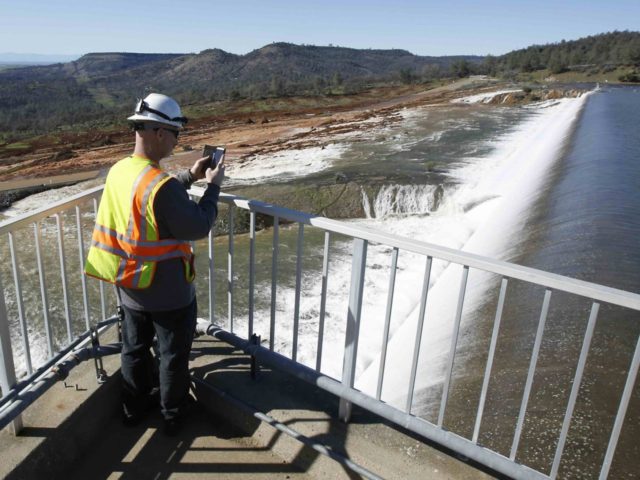The California Department of Water Resources (DWR) technical report has admitted that 75 percent of the newly repaired cement slabs in the Oroville Dam’s spillway already have cracks.
The DWR report for the California-owned dam was issued on Nov. 2 was in response to an Oct. 2 cautionary letter from the Federal Energy Regulatory Commission that noted that a majority of the rebuilt spillway had observable “cracking of the erosion resistant concrete.”
DWR’s December 7 public presentation to City of Oroville and downstream Feather River residents near America’s tallest dam deteriorated into a screaming match after the state’s dam experts tried to reassure the community that there was nothing to see in the string of what were described as only “hairline cracks” that developed just weeks after Kiewit Corporation finished its $275 million first phase contract to rebuild the 1,700-foot spillway.
The DWR stated at the presentation that it had inspected the cement top sheet that was poured and then roller-compacted and smoothed shortly before the November 1 contract deadline before certifying the first phase of the massive repair job as completed on time.
The DWR expert report to FERC was issued a day after the construction deadline revealed that over 157 of the 228 rebuilt cement slab panels, which measure 37-by-30-feet, had “random” surface observable cracks with an average length of 80 linear feet per panel. According to the report:
- 50 percent subject cracked panels have extremely thin cracks;
- 40 percent of the cracked panels have cracks that are hairline width; and
- 10 percent of the cracked panels have cracks of about an eighth of an inch.
DWR acknowledged: “Most of the edge cracking appears to arrest at the top mat of reinforcement with some progressing through the entire panel.”
DWR stated that “cracking was anticipated” due to the highly restrained nature of the spillway panels that are anchored to the dam foundation, and have “continuous bottom mat reinforcement and keyways between adjoining panels. DWR stated: “By design, location, spacing and amount of reinforcement was intended to distribute cracking and keep it at a hairline level,” according to the American Concrete Institute’s acceptable widths.
Some of the cracking was due to “thermal shrinkage” from large daily temperature swings in late summer, but the major reason for cracking appears to be from “plastic shrinkage” during the contractor’s water cure procedures that normally includes quickly laying wet fabric on the newly poured cement to prevent rapid surface moisture evaporation, compared to the drying of internal cement. According to DWR experts:
“Several instances occurred where the contractor did not immediately install water cure on the panel following the finishing efforts, as well as instances where the water cure was terminated or disrupted by other onsite operations.”
DWR experts acknowledged that Oroville Dam Spillway cracking could create a long-term safety risks, because “[p]lastic shrinkage cracks begin as shallow cracks but can become full-depth cracks later in the life of the concrete.”
Photo: file

COMMENTS
Please let us know if you're having issues with commenting.